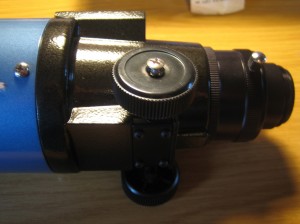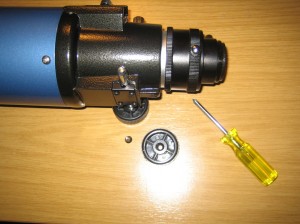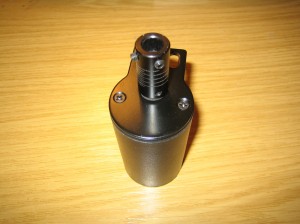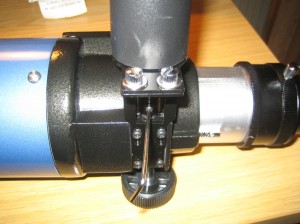One of the problems with the ST80 and ST102 on the EQ1 mount is the amount of “wobble” when changing focus, which not only takes a while to settle down afterwards, but makes it more difficult than it need to be actually determine when the scope is in focus in the first place. I put up with the problem for a while, but when someone mentioned in passing that Skywatcher have a motorised focus drive, I thought I’d give it a try. I bought mine from First Light Optics, but they’re available from many different suppliers, often misleadingly called an “autofocuser”.
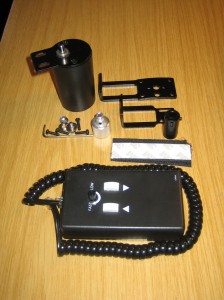 The drive arrived as a kit of parts, some of which weren’t necessary for my scope(s), including the motor, controller, battery, cable, two mounting brackets, four screws for retaining the mounting plate, two knurled and slotted screws for attaching the motor to the mounting plate, a plastic “universal joint” type drive connector, an Allen key, a length of self-adhesive velcro and a metal connector which appears to have an O-ring in the open end that was already fitted to the motor output shaft. This clearly wasn’t intended to fit anything I was going to use it for, so I had to remove it (with some difficulty — it was quite stiff even after I’d removed the retaining grub screw completely). Oh, and an A4 sheet of instructions which, whilst OK, weren’t brilliant. I assume the larger mounting bracket is for some of the other scopes that the kit fits and I didn’t use the four retaining screws because the existing ones held the mounting bracket I used without any problems.
The drive arrived as a kit of parts, some of which weren’t necessary for my scope(s), including the motor, controller, battery, cable, two mounting brackets, four screws for retaining the mounting plate, two knurled and slotted screws for attaching the motor to the mounting plate, a plastic “universal joint” type drive connector, an Allen key, a length of self-adhesive velcro and a metal connector which appears to have an O-ring in the open end that was already fitted to the motor output shaft. This clearly wasn’t intended to fit anything I was going to use it for, so I had to remove it (with some difficulty — it was quite stiff even after I’d removed the retaining grub screw completely). Oh, and an A4 sheet of instructions which, whilst OK, weren’t brilliant. I assume the larger mounting bracket is for some of the other scopes that the kit fits and I didn’t use the four retaining screws because the existing ones held the mounting bracket I used without any problems.
The first job is to remove one of the focusing wheels, by removing the screw in the centre and then just easing it off. I’ve fitted this kit to both my ST80 and ST102 and whilst the ST80 wheel came off easily, the ST102 was very stiff and needed a certain amount of carefully levering to remove it:
With the wheel removed the two screws nearest that end of the focusing shaft can be removed from the plate covering the pinion wheel and the motor drive mounting bracket refitted with the same screws. I did them up just tight enough to hold the bracket in place without slopping around so I’d be able to move it into the correct position to fit the motor drive:
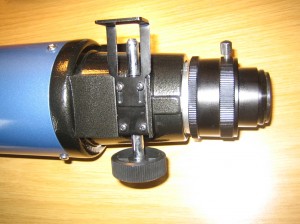
I fitted the plastic connector onto the motor next. The shaft has a flat on it for the grub screw to bear on so orientation matters whereas the focusing shaft doesn’t and the other end of the connector will go on in any orientation. However, it’s worth aligning the connector before putting it over the focusing shaft to allow easy access to the two grub screws for tightening them onto the shaft:
With the motor connected I connected the motor housing to the mounting bracket and tightened up the screws on the bracket itself. Before connecting everything up the battery needs to be fitted into the controller. I found there to be almost no free space around the battery for the connector cables and couldn’t get the battery compartment cover closed with the battery in place, so ended up undoing the four screws on the back of the controller to allow the cover to be put in place, then screwed them back down:
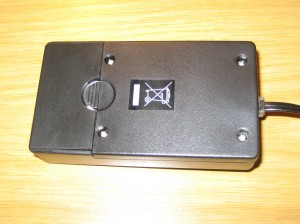
Finally, connect up the cable — either way around seems fine — and test it.
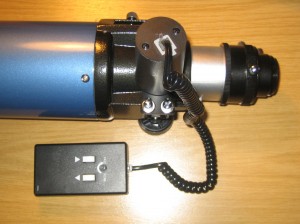
I was concerned that I’d find using the controller to focus the scope rather than the focus knob a nuisance, but actually as long as I keep the controller somewhere it’s easy to find without taking my eye from the eyepiece when I need to, it’s fine, and the entire process of focusing is far easier because the image stays beautifully steady. Learning which button moves the focus in which direction and which way you need to turn the speed controller to make the movement faster or slower takes a while to get the hang of, but it’s no different from getting used to the slow motion controls or the clutch locks on the RA/dec axes. It also helps if the cable is fixed to the scope body somewhere to stop its weight dragging the focuser end of the scope down when the clutch locks are released.
I found one additional problem with the ST80. Without the motor drive the scope would only balance in the rings if it was as far forward as possible, with the screws attaching the scope tube to the focuser housing tight up against the rear scope ring. With the motor fitted the scope wouldn’t quite balance without additional weight at the front of the tube.
All in all I’m very happy with the improvement the motor drive has made. A more rigid mount would also solve the problem, I’m sure, but this is a very acceptable alternative until I can justify spending that kind of money

